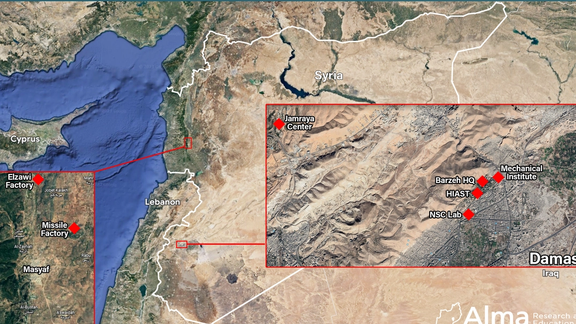Iran Invests In Syrian Weapons Plants Amid Poverty At Home

New research shows Iran’s investment into weapons plants in Syria continues, at the expense of the Iranian people suffering the worst economic crisis in decades.

New research shows Iran’s investment into weapons plants in Syria continues, at the expense of the Iranian people suffering the worst economic crisis in decades.
Israel’s Alma, an institute focused on threats to northern Israel, has revealed in a detailed report that “Iran’s major focus is to develop and manufacture precision missiles and rockets, cruise missiles, and unmanned aerial vehicles (UAVs) on Syrian soil”.
Operations are centered around the CERS Center, which is the heart of Syria's military industry. Established in 1971, the institute has transformed into a collaborative platform involving Syria, Iran, and Hezbollah since the beginning of the civil war, according to Alma's statement.
Security monitoring has been intensified by the Quds Force and Hezbollah’s security unit in Syria, Unit 9000. Iran’s control has become almost absolute, with a full-time presence of senior IRGC Quds Force Officers at the site.
In 2020, it was revealed by a prominent lawmaker that Iran had spent between $20 billion and $30 billion in Syria to prop up President Bashar al-Assad and fight Islamic State but as revelations of Iran’s growing industrial capabilities continue, the true number is believed to be far higher.
“We have probably paid $20-30 billion to Syria, and we have to take that money back,” Heshmatollah Falahatpisheh, a member of the Iranian parliament's national security committee, said in an interview with Etemad Online at the time. Little has changed since, regime activities in Syria seeming to only step up, not down.
In May, Iran International reported that based on leaked documents from the Iranian foreign ministry, that Syria owes Iran $50 billion.

Iranians often express strong disapproval of the regime’s regional policy of establishing and supporting militant groups and its involvement in Syria, while inflation has surpassed 50 percent in Iran. The national currency has fallen 12-fold in the past five years and nearly half of the population lives below the poverty line. Slogans during nationwide anti-regime protests since 2017 have called for stopping aid to Hezbollah and Palestinian militants.
Over the years, Syria’s CERS Center has been shown to be accountable for the research, development, and military production of advanced weapons such as surface-to-surface missiles such as the M-600 / Fateh-110 missile, which is “at the heart of the joint Iranian-Syrian and Hezbollah precision project", Alma reported. More alarmingly, it states that “the CERS Center is responsible for developing and manufacturing chemical, biological, and potentially nuclear weapons”.
Alma believes Syria now “possesses extensive chemical capabilities,” which it believes to be “a guarantee of its survival”. More alarmingly, the researchers warn that it could be these very chemical weapons which pose the next greatest threat to Israel.
“At will, this capability may benefit the radical Shiite axis led by Iran in general and Hezbollah in particular. Hezbollah’s use of chemical weapons in the next confrontation with Israel cannot be ruled out.
“It is conceivable that missiles/rockets armed with chemical weapons (such as Sarin nerve gas) are being stockpiled for use by Hezbollah in one of the CERS center’s sites in the Masyaf area and will be transferred to Lebanon if so directed,” claimed Alma’s assessment. “We estimate with a high probability that in a situation of war, Israel will attack the chemical weapons stockpiles wherever they are, in Syria and/or Lebanon.”
Just last year, Syrian Prime Minister Hussein Arnous announced that he would welcome Iranian companies seeking to partner with economic institutions in Syria, under the pretext of serving the reconstruction process and carrying out investment projects.
Also last year, the Iranian minister of roads and urban construction visited Damascus where contracts were signed in the fields of transport, investment, petroleum products and infrastructure, all the while in Iran, thousands of citizens are still dying on the treacherous roads and suffering the consequences of its dire infrastructure.
Iranian economic expansion in Syria means giving Tehran the leverage to exercise control after the war, which means long-term influence in Syria, even without the need for a military presence.
This influence means that the regime can also be within shorter striking distance of its archenemy Israel, as was seen earlier this year when a multi-front attack saw Israel bombarded with rockets from Gaza, Lebanon and Syria as Iran’s wrath surrounded the Jewish state via its collection of proxy militias.